Mining is an industry where the goal is to extract minerals at the maximum possible efficiency while minimizing environmental impact. It sounds simple, but the innovation that lies behind mining, processing, and smelting operations is incredibly deep. And, it’s getting more complex all the time where the world’s global logistics systems allows mines world-wide to compete with each other, so efficiency and scale matters more now than ever. While extraction and processing efficiency have never been more important, the world toleration for the negative environmental impact that often comes with mining is at an all-time low. Successful mines find approaches that minimize environmental impact, protect workers health, contribute to the local economy and are still efficient enough to operate profitably in a highly competitive world market.
For mining companies, I’m sure all these competing pressures make work difficult, but for us, we love seeing the evolution that comes from intense competition and conflicting goals. All industries have different opportunities for innovation and even different mining operations face different challenges so we didn’t know what to expect from our day at Richards Bay Minerals near Richards Bay, South Africa, but we knew we would learn a lot. It was a successful day.
Richards Bay Minerals has an unusually diverse product set. They produce Titanium Dioxide, Pig Iron, and Zircon. Titanium Dioxide is primarily used as a pigment in paints, varnishes, paper, plastics, printing ink, rubber, cosmetics, and some foods. Pig Iron is an intermediate product that is used in the production of steel and various finished iron products including gray iron, cast iron and ductile iron. Zircon has application as an opacifier and also is the base product for the production of metallic Zirconium and other compounds of Zirconium including Zirconium Dioxide. An example use of an opacifier is to make glass opaque for applications where light is desired by privacy is still needed.

|
RBM has mining leases on a three tracts of land along the Indian Ocean coast of South Africa north of Richards Bay. The feedstock for all the RBM products are the sand dunes just inland from the sensitive habitat along the ocean edge. These dunes will eventually be fully processed. But rather than accept the environmental blight that is left by open pit mining, the RBM technique is effectively a self-healing, mobile mine site. It’s huge – much larger than a professional sports arena, but it’s in motion. Each day the mine site moves a bit more than a meter where the entire sand tower from clay to the top of 300-ft dunes is brought into the plant for concentration, and the valuable mineral content is removed and trucked to the processing plant. Most of the material remains as tail stock. The “mobile mine” consumes dunes in front of it and out the back side the dunes are re-poured into the same form of rolling hills and then replanted.

|
If you survey the skyline around the mine from the road you see untouched dunes with vegetation to the left, the processing plant in the middle floating in water used to wash the sand down to be dredged up for processing. All processing of the material is done on site in a slurry and, when the processing is compete, trucks take away the concentrated minerals for further processing and the tail stock flows to the right side of the plant where it is pump back up to form the hills that were originally there. As you look further to the right you see first freshly poured dunes, then light vegetation, and then off in the distance to the right, more mature vegetation effectively getting older the further you look to the right. It’s amazing to watch, the scale of the operation is stupendous and, if you have ever been to an open pit mine, you’ll really appreciate what a difference this is. Rather than an ever-expanding blight as the pit gets bigger, we have a small pit that moves slowly, reforming what was in front behind it.

|

|
The concentrated ore leaves the mine in massive 144-ft long road trains. These are innovations that were first implemented in Australia’s vast Northern Territory. Rather than a single tractor trailer or even two trailers behind a highway tractor, they have four. These 144-ft foot long monsters run the nearly 30-km, mostly straight road from the mine to the processing plant. They are incredibly efficient and can carry similar loads to the biggest mining trucks but they are less hard on the highway surface and can operate in standard width highway lanes.

| |

|
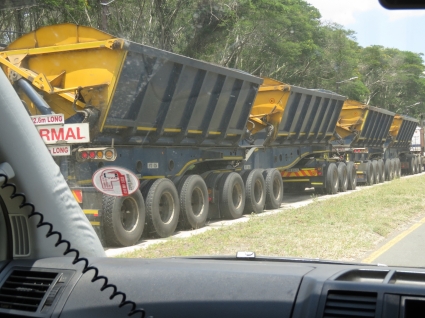
|
In order to extract material in concentrated form many different techniques are used in the plans. The material is first put through screens to limit the size of the process input material.

|

|
Gravity is used in row after row of rotary sluices that spin the material in water which causes the dense material to separate from the less dense. If you look carefully you can see the material is separated into two separate runs at the bottom of the sluice below.

|

|
Low intensity magnetic separators use stacks of magnetic rollers where the more magnetic material tends to stick to the roller longer whereas the less magnetic falls off quickly. There is a splitter that separates the materials and this process is repeated and the material falls past roller after roller.

|

|
Wet High Intensity Magnetic Separators use very strong magnetic fields that are interrupted as the material rotates allowing magnetic partials to fall at the point of magnetic field interruption.
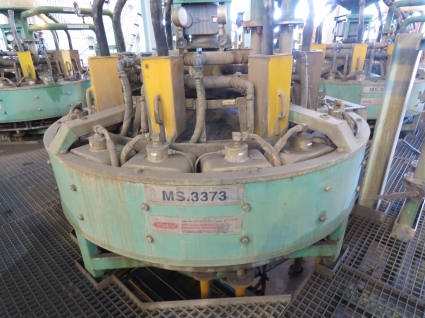
|

|
Many processes are more effective when the material is heated so large furnaces are employed as well. And many processes continue to produce higher refinement when repeated so many steps are repeated multiple times.

|
|

|
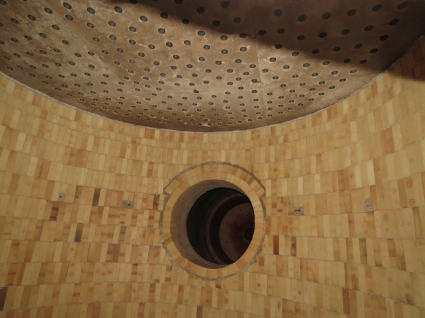
|
This is a sulfuric acid bath used as a final form of purification, only when producing the most pure product.
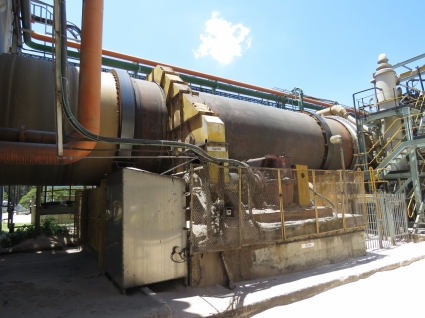
|
Below, loading high grade material onto a truck for final shipment.

|

|
Thanks to Joey Kunji-Behari, General Manager of Smelting, Processing, and Logistics; Fundi Dlamini, General Manager of Community and Corporate Relations; and Michael Blose, Tour Guide, for hosting us at Richards Bay Minerals.

|
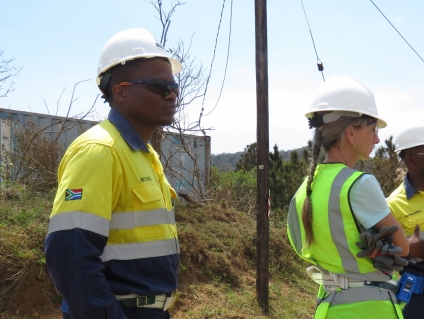
|

|
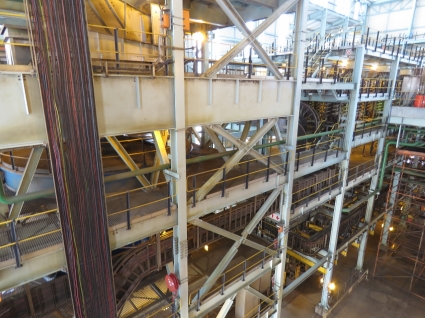
|

|

|

|

|
If your comment doesn't show up right away, send us email and we'll dredge it out of the spam filter.

(By the way, congrats on getting access to yet another amazing industrial facility. I’m wearing magenta just to hide my turning a little green.)
Yeah, you’re right Frank, we got lucky on this one and it was a pretty cool day.
James
Thx for the information interesting
Multi deck screen is one where the input stream is separated into various size fraction. For example a 3 decj screen would have 3 screens with a 12 mesh,46 mesh and 100 mesh giving 4 output streams: +12, -12/+46, -46/+100 and -100
Depending on the sizes one needs one changes the mesh of the screen
Hope this helps
Rod
Got it. Thanks Rod. Becuase the screening section is high up in the plant, we didn’t directly see it.
Since the material being processed is fairly uniform sized sand I suspect they screen stage is only used to keep big material out but isn’t being used as a primary sort and concentration technique.
I am now long retired from working at RBM and on Rio projects. The screen is mainly used to remove materials such a vegetation left from the forest clearing to get to the sand and the odd rock or bulldozer blade tips. You may want to visit QMM another Rio Tinto sand mining operation in Madagascar. Great pics. Thanks for taking me down memory lane
Thanks for the background on how the system work from a long time employee. Thanks for posting.
James
Do you know if the high intensity magnets were rare earth permanent magnets?
I utilised such magnets for the aluminum oxide abrasive grain plant I designed – these magnets look similar.
Permanent rare earth magnets are as good as old faahioned electromagnets but are, obviously, much cheaper and easier to operate
Also did RBM employ any multi deck screens in the process?
Thanks
Rod
Hi Rod. The high intensity magnets are large fluid cooled electro magnets. They do use physical screens on input to the process. What is a multi-deck screen?
That is a fascinating approach to open cast mining. The diagram suggests that the mobile mine, like the “dredger” excavating the dune, is floating on water rather than planted on land. Is this a correct reading?
In an earlier comment you mentioned you were interested in visiting the Land Rover factory (the main one is based in Solihull in the UK Midlands). By coincidence I was there last Thursday evening for a preview of the Jaguar F-Pace, its new SUV, and asked about factory visits. Apparently they get about 17,000 a year visiting Land Rover Experience there, some for the factory tour and some just for off road driving. They do charge, £45 for the tour in a group, or £295 just for two. The guide we had for the factory part of my visit was excellent. Please let me know if you want a contact number.
David, your read is correct. There is a pond at the center and on the pond, floats the initial concentrator plant and 1 or 2 dredgers (depending upon the min). Each dredger is connected to the concentration plant by floating pipes. The dregers float to where they want to be and use two pilings that can be jacked down into the bottom to keep the dredget in place. The dredgers spray water in front of them which causes the dune to collapes in sheets into the pond. The dredger digs up the material that has slipped into the poind and then pumps the slurry of sand and water to the concentration plant. The plant floats on a very large barge and it is responsible for doing initial concentration.
The target material is moved through pipes in a slurry to be be loaded onto mining trucks not far from the conentration plant. The tailings are also pumped through pipes in a slurry where they reform the dunes behind the active part of the mine site. The entire massive assembly moves a bit more than a meter a day.
Yes, the entire concentrator plant and dredger are floating. The dredger was built by IHC, of the Netherlands. The dredger moves crab like using to independent ‘spuds’ mounted on movable spud carriages.
We enjoyed watching the dredger and the 4 trailer road trains taking material to be processed to the plant was impressive as well. We’ve only seen road trains in South Africa and the Australian outback.
What are those blue devices I see Jennifer wearing on the belt?
Good catch Tim. Everyone on the mine site must wear one of those blue boxes on their belts. All the heavy equipment on site is instrumented so that if heavy equiment is operating near to a person, the person is warned to leave the area. If they don’t move, the heavy equipment operators is warned and instructed to slow down. If the distance closes further the heavy equipment operator is stopped until the person leaves the imediate area.
It’s a pretty good idea in that that mining trucks, skidder operators, and larged tracked vehicle operators are focused on the operation at hand and may not notice a person walking into the immediate area and a person may not notice heavy equipment operator just below the rise of the dune.
The equipment operating at a mine site is so big that even an entire pickup truck could be crushed by accident.
So the devices stop the vehicle themselves or just instructs the driver to stop? Either way that is a very good safety device. I am a former safety coordinator in the construction industry so that is very intriguing to me.
I believe it is advisory rather than a programatic shut down but I’m not 100% sure on that one Tim. Clearly you could easily program a 100% shutdown but I suspect removing power at some points in complex heavy equipment operations could pose a risk to the equipment operator. Advisory might be safer over all.